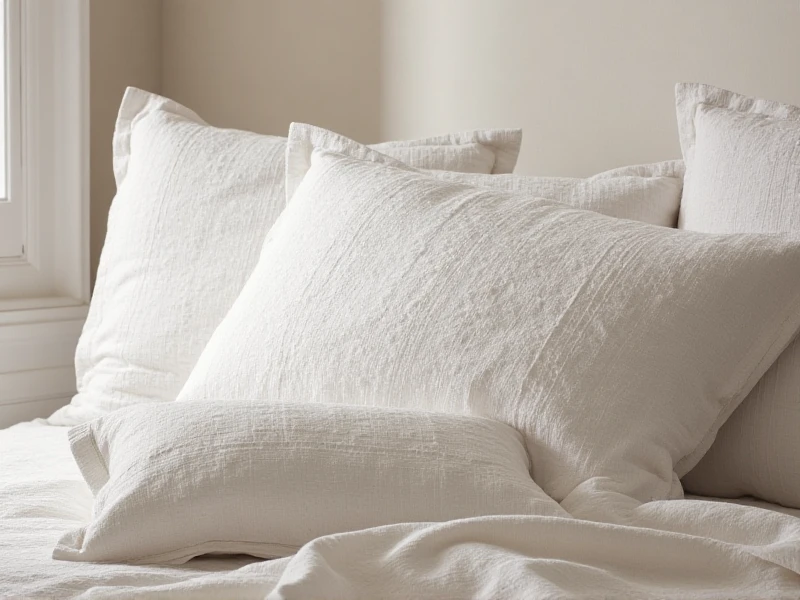The Ultimate Pillowcase Guide: Materials, Benefits & Buying Tips
2025-06-06

Here's an SEO-optimized article about pillowcases in English, incorporating your requirements:
Choosing the right pillowcases is more than just a decorative decision. They directly impact your sleep quality, skin health, and even your hair's appearance. With so many materials and options available, finding the perfect pair can feel overwhelming. This comprehensive guide explores everything you need to know to make an informed choice and elevate your sleep experience.
Why Your Pillowcase Matters More Than You Think
Think of your pillowcase as your face's primary contact point for hours every night. It absorbs oils, sweat, and skincare products. The wrong material can cause friction, leading to hair breakage, "sleep wrinkles," or irritation, especially for sensitive skin. High-quality pillowcases, however, offer tangible benefits:
Enhanced Skin Health: Materials like silk or satin create less friction against your skin, potentially minimizing overnight creasing and reducing irritation for acne-prone or sensitive complexions.
Hair Protection: Friction can cause tangles, frizz, and breakage. Smooth pillowcases significantly reduce hair pulling and damage.
Improved Temperature Regulation: Breathable fabrics like high-quality cotton help wick moisture and keep you cool throughout the night.
Increased Comfort & Sleep Quality: There's nothing quite like resting your head on soft, cool, luxurious fabric after a long day.
Popular Pillowcase Materials Explained
Understanding core materials is key:
1. Silk Pillowcases (Mulberry silk is best): The gold standard for minimizing friction. Benefits include reduced hair frizz/breakage, less skin creasing, and naturally hypoallergenic properties. Ideal for hot sleepers. Requires gentle care (hand wash or delicate cycle). Expect a higher price point.
2. Satin Pillowcases: Often made from polyester or nylon, satin offers a similar low-friction surface to silk at a more affordable price. Good for hair protection and skin comfort. Less breathable than silk or cotton; may trap heat. Can feel cool to the touch initially but might not manage moisture as well over time.
3. Cotton Pillowcases: The classic choice. Popular varieties include:
Pima/Pima Cotton: Soft, durable, long fibers for a luxe feel.
Supima Cotton: Guaranteed extra-long staple cotton fibers, ensuring exceptional softness and strength.
Thread Count Consideration (300-600 is often optimal): While higher counts sound better, excessively high counts with poor-quality yarns are less breathable.
Weaves:
Percale: Crisp, cool, matte finish. Highly breathable.
Sateen: Silky-smooth, slight sheen, warmer than percale. Gentle on skin/hair.
Jersey: Knitted, stretchy fabric like a comfy t-shirt. Very soft but can pill over time.
Organic Cotton: Grown without harsh pesticides, offering an eco-conscious option, often gentler on sensitive skin.
4. Bamboo Pillowcases (Typically bamboo rayon/viscose): Naturally hypoallergenic and antibacterial. Incredibly soft and silky, offering moisture-wicking and temperature-regulating properties. A great eco-friendly alternative with a smooth feel.
5. Linen Pillowcases: Exceptionally breathable and moisture-wicking, perfect for hot sleepers. Highly durable and gets softer with each wash. Offers a unique, textured rustic look. Naturally antimicrobial. Wrinkles easily.
6. Flannel Pillowcases: Woven from cotton, usually brushed for exceptional softness and warmth. Ideal for cooler climates or winter months. Provides cozy comfort. Less suited for hot sleepers or warm seasons.
Choosing the Best Pillowcase for Your Needs
Consider these factors:
1. Primary Concern:
Hair Health/Frizz Control? Prioritize silk or satin.
Skin Sensitivity/Acne/Wrinkle Prevention? Opt for silk, satin, or high-quality sateen cotton.
Hot Sleeper? Look for percale cotton, linen, or bamboo.
Cold Sleeper? Flannel offers cozy warmth.
Durability? Linen, high-quality cotton, and silk are winners.
Budget? Cotton and satin are generally more affordable options.
2. Feel Preference: Do you like cool/crisp (percale), silky smooth (silk/satin/sateen), super soft cozy (flannel/bamboo jersey), or textured/breezy (linen)?
3. Care: Consider your willingness for maintenance. Silk needs gentle care; cotton and linen are generally low-maintenance; flannel often washes well; satin varies by fiber base.
4. Ethics & Environment: Seek out certified organic cotton, OEKO-TEX® certified, or sustainably sourced bamboo/linen.
Essential Pillowcase Care Tips
Wash Regularly: Launder pillowcases at least weekly. Oils, sweat, and dead skin accumulate quickly.
Follow Care Instructions: Silk requires cold water, gentle detergent, and low heat/no heat drying. Cotton linens generally handle warm water well. Check labels.
Use Non-Abrasive Detergents: Avoid harsh chemicals or bleach that can damage delicate fabrics like silk.
Gentle Drying: Air drying is best for longevity, especially silk and satin. Use low heat if necessary for others. Remove promptly to minimize wrinkles.
Upgrade Your Sleep Tonight
Your pillowcase is a simple yet powerful upgrade for your nightly routine. Whether it’s protecting your skincare investment, taming frizzy hair, cooling you down, or simply adding indulgence to your bed, the right choice makes a real difference. Take the time to consider your priorities – your skin, hair, comfort, and ultimately, your sleep will thank you. Explore different materials and discover the blissful feeling of slipping into bed with the perfect pillowcase. Investing in quality sleep always pays off.
Category: